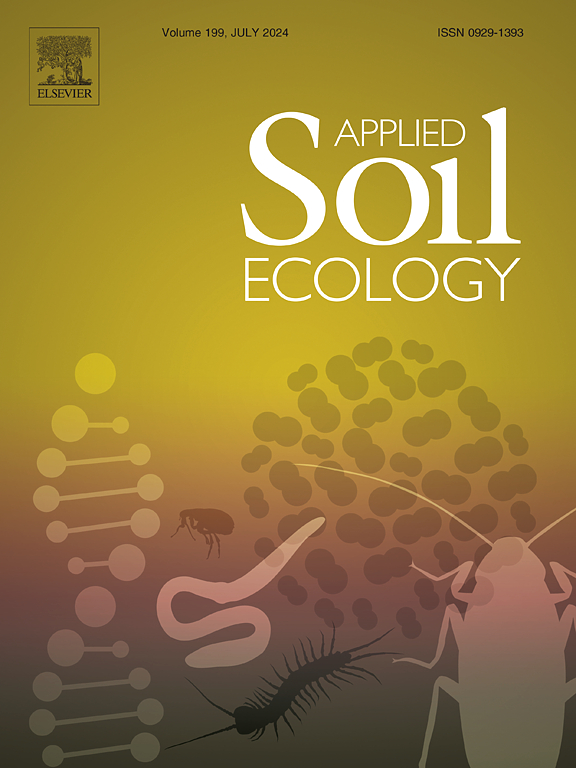Inorganic amendment can delay the degradation of organic amendment by enhancing its resistance and mitigating microbial activities in saline–alkali soils
IF 5
2区 农林科学
Q1 SOIL SCIENCE
引用次数: 0
Abstract
Soil organic matter (SOM) plays a crucial part in improving soil quality, promoting soil microbial activities, and buffering salt stress, in saline-alkali region. Organic amendment effectively improves the quality and C storage in saline-alkali soil, while it still remains tenuous that how can inorganic amendment affects SOM composition and microbial characteristics when applying organic amendment. An 800-day incubation experiment in saline-alkali soil were conducted with treatment of organic amendment (furfural residue) and a mixture of organic amendment and inorganic amendment (furfural residue and mineral amendment, 4:1). Our results showed that adding mineral amendment based on furfural residue 1) increased the contents of particulate organic carbon, total lignin phenol, cellulose, humic acid (HA), HA-C, and silt-clay-C by 17.64 %, 20.28 %, 168.32 %, 27.62 %, 28.15 % respectively; 2) improved the aromaticity of solid-state SOM and HA, reduced the potential transformation of HA (especially lignin-like compounds), and increased newly generated lignin-like and condensed aromatic-like compounds in HA; 3) reduced microbial biomass and necromass C respectively by 40.08 % and 15.58 %, changing C-degrading enzyme activities and bacterial communities. These findings indicated that extra additive inorganic amendment can reserve plant-derived C and slow microbial-derived C formation by mitigating microbial activities and protecting degradation reactants and products in HA (especially lignin-like and condensed aromatic-like compounds). This study provides direct experimental evidence for the sustainable development of inorganic amendments in the remediation work of saline-alkali soil.

无机改良剂可以通过增强有机改良剂的抗性和抑制盐碱地微生物活性来延缓有机改良剂的降解
盐碱区土壤有机质在改善土壤质量、促进土壤微生物活性、缓冲盐胁迫等方面起着至关重要的作用。有机改良有效提高了盐碱地土壤质量和碳储量,而无机改良在施用有机改良时对土壤有机质组成和微生物特性的影响尚不明确。采用有机改良剂(糠醛渣)和有机改良剂与无机改良剂(糠醛渣与矿物改良剂比例为4:1)混合处理,在盐碱土中进行了800 d的培养试验。结果表明:添加糠醛渣矿物改进剂1)使颗粒有机碳、总木质素酚、纤维素、腐植酸(HA)、HA- c和粉土-c的含量分别提高了17.64%、20.28%、168.32%、27.62%、28.15%;2)提高了固态SOM和HA的芳香性,降低了HA(特别是木质素样化合物)的潜在转化,增加了HA中新生成的木质素样化合物和缩合的芳香样化合物;3)微生物量和坏死块C分别减少40.08%和15.58%,改变了C降解酶活性和细菌群落。这些结果表明,额外添加无机改性剂可以通过降低微生物活性和保护HA中的降解反应物和产物(特别是木质素类和缩合芳香族化合物)来保留植物源C和减缓微生物源C的形成。本研究为无机改良剂在盐碱土修复工作中的可持续发展提供了直接的实验依据。
本文章由计算机程序翻译,如有差异,请以英文原文为准。
求助全文
约1分钟内获得全文
求助全文
来源期刊

Applied Soil Ecology
农林科学-土壤科学
CiteScore
9.70
自引率
4.20%
发文量
363
审稿时长
5.3 months
期刊介绍:
Applied Soil Ecology addresses the role of soil organisms and their interactions in relation to: sustainability and productivity, nutrient cycling and other soil processes, the maintenance of soil functions, the impact of human activities on soil ecosystems and bio(techno)logical control of soil-inhabiting pests, diseases and weeds.
 求助内容:
求助内容: 应助结果提醒方式:
应助结果提醒方式:


